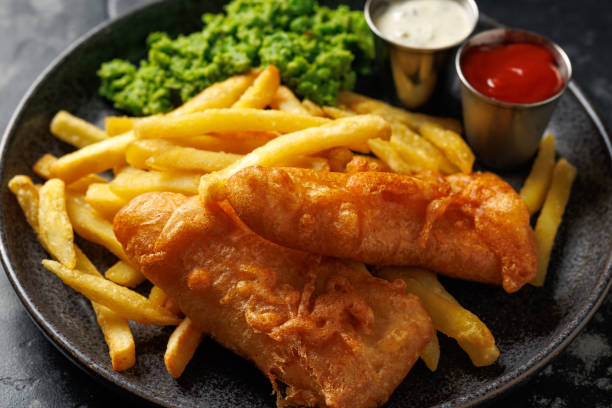
A Brief History
Fish and chips first appeared in Britain during the 19th century, a time when the Industrial Revolution was transforming the way people lived and ate. Fried fish was introduced by Jewish immigrants from Portugal and Spain, while fried potatoes became popular thanks to vendors in France and Belgium. The two came together in the 1860s when Joseph Malin opened the first fish-and-chip shop in London. From then on, it became the go-to meal for workers cheap, filling, and satisfying. During World War II, it was one of the few foods that weren’t rationed, cementing its place in British hearts forever. The meal became more than just food it was a sense of comfort during difficult times and a symbol of unity. Even today, nearly every British town has a local chippy, and the tradition continues strong.
What Makes the Perfect Fish and Chips
Authentic fish and chips are all about quality ingredients and timing. The fish—traditionally haddock or cod—should be fresh, firm, and mild-flavored. The batter must be light, bubbly, and crisp, not greasy or heavy. And the chips? Thick-cut from floury potatoes like Maris Piper, fried twice for that golden crunch and soft, fluffy center. The right oil temperature (around 180 °C / 356 °F) is key to achieving that iconic crispiness. The fish and chips should complement each other: crunchy exterior, tender interior, perfectly seasoned. A sprinkle of salt and a dash of vinegar complete the experience, bringing out every flavor note from sea to plate.
►INGREDIENTS
For the Chips
- 5 – 6 large Maris Piper potatoes
- Water
- 2 tsp salt
- 1 tsp baking soda
- 2 tbsp distilled vinegar
For the Fish - 1 kg haddock or cod
- 2 tsp salt
For the Flour Mix - 1 cup (120 g) plain flour
- 2 tsp black pepper
- 1 tsp salt
For the Batter - 2 cups (240 g) plain flour
- 2 tbsp corn flour
- 2 tsp baking powder
- 500 ml cold soda water
For Frying - 1 litre sunflower oil
For the Tartar Sauce - ½ cup mayonnaise
- 2 pickled gherkins
- 1 pickled red chilli
- 1 tbsp capers
- 1 small shallot
- Juice of half a lemon
- 1 tsp Dijon mustard
- 2 tsp Worcestershire sauce
- ½ tsp salt
- ½ tsp black pepper
- 1½ tbsp fresh dill
Step-by-Step Preparation
1. Make the Chips
Peel and slice the potatoes into thick chips. Rinse in cold water to remove excess starch. Boil them for 5–7 minutes in salted, vinegared water with baking soda. Drain and let them dry. Fry once at 130 °C (265 °F) until tender but pale, then let them cool. For the second fry, raise the oil to 180 °C (356 °F) and cook until golden and crisp. Sprinkle with salt while still hot for that authentic British touch. The double-frying method ensures the inside stays soft while the exterior gets its signature crunch.
2. Prepare the Fish
Pat the fish dry and season with salt. Dredge each fillet in the flour mix—this helps the batter stick. Dip into the cold soda-water batter and immediately place in the hot oil. Fry until golden and crispy, about 6–8 minutes. Don’t overcrowd the fryer—cook in batches so the oil stays hot. The result should be light, golden, and crackling with texture.
3. Make the Tartar Sauce
Finely chop the gherkins, chilli, shallot, and capers. Combine with mayonnaise, lemon juice, mustard, Worcestershire sauce, salt, pepper, and dill. Mix well and chill until serving. The sauce’s creamy tang perfectly balances the fried fish and enhances the freshness of each bite.
Serving and Enjoying
Traditionally, fish and chips were wrapped in newspaper, a nostalgic nod to simpler times. These days, parchment paper or a serving basket does the trick. Serve the fish on top of the chips, add a wedge of lemon, and spoon over plenty of tartar sauce. For the full British experience, drizzle malt vinegar over your chips and enjoy with mushy peas or pickled onions on the side. Nothing beats the sound of that first crunch or the steam rising from freshly fried food on a cool evening. For drinks, a chilled beer or a cup of English tea rounds out the meal perfectly.
Tips for Success
Keep the batter cold; it makes the coating lighter and crispier. Fry in small batches for even results. Always rest the fried fish on a wire rack instead of paper towels to prevent sogginess. Use fresh oil when possible—old oil can make the fish taste heavy. Finally, serve immediately after frying; fish and chips are best enjoyed piping hot, right out of the fryer.
Conclusion
Fish and chips isn’t just a dish—it’s a British institution. From busy city centers to quiet seaside towns, this classic meal brings people together with its simplicity and heartwarming flavors. Crispy, warm, and satisfying, it’s comfort food at its best. Whether cooked at home or bought from your favorite local chippy, it’s a timeless experience that never fails to delight. One bite, and you’ll understand why it remains Britain’s most beloved meal.
Please don’t forget to leave a review.
